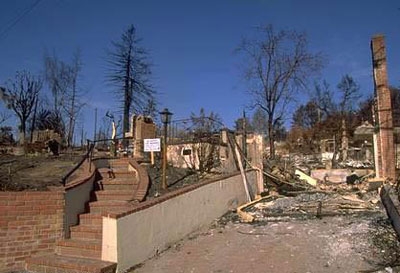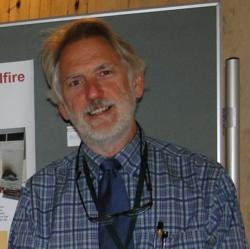Posts Tagged: fire
Oakland Hills fire prompted changes in building laws
Fighting the wildfire was hampered by steep and narrow roads, houses with wood-shingle roofs, a restricted water supply, and fire hydrants that were incompatible with neighboring cities’ trucks. The wildfire, which burned for almost 72 hours, took 25 lives, devastated over a thousand acres of land, and destroyed more than 3,500 homes.
Oakland now requires all new Oakland Hills houses to have fire-resistant roofs, which include slate, clay, concrete roof tile or steel shingles, according to the Builders Wildfire Mitigation Guide, published by the UC Division of Agriculture and Natural Resources.
“These materials are more accessible now than in 1991,” said Steve Quarles, a researcher at the Insurance Institute for Business and Home Safety, a Florida-based organization that conducts studies on natural disasters aimed to reduce human and financial loss. Quarles retired from UC Cooperative Extension Aug. 1 after serving for 26 years as a wood durability advisor. “Probably most of them were available at that time, but now they are less expensive and people can acquire more information about them.”
How to decipher nutrition labels
Claudia Mosby, The Redding Record-Searchlight
A heart-healthy, sugar-free or low-fat label on your favorite box of crackers at the store doesn't automatically mean it's a healthy food item. These eye-catching labels draw attention to what may be a healthier choice, but to accurately assess the item's nutritional value you need to read and understand its nutrition facts label.
According to Concepcion Mendoza, nutrition family and consumer science advisor at University of California Cooperative Extension in Shasta and Trinity counties, nutrition facts labels became mandatory in the early 1990s. These labels list the number of calories, fat grams and nutrients per serving for a food item, along with its percent of daily value recommendation.
Steve Quarles takes job with insurance institute
The Insurance Institute for Business and Home Safety announced last week that Stephen Quarles will join the IBHS research team as senior scientist - hurricane/high-wind building durability and fire protection.
He will also occupy the South Carolina Wind and Hail Underwriting Association Hazard Resilience Chair at the IBHS Research Center.
Quarles has been a wood durability advisor for UC Cooperative Extension since 2000.
“Although my years with UC Cooperative Extension were very rewarding, I could not pass up the opportunity to work for IBHS and in particular at the Research Center with its scientists and staff," Quarles was quoted in the news release. "I am excited to have a more direct role in IBHS research and outreach activities that will help improve the durability of our new and existing buildings.”
Quarles has a bachelor's degree in forestry from Virginia Tech, and master's and doctorate degrees in forest products from the University of Minnesota. He is co-chair of the eXtension Wildfire Information Network (eWIN) Community of Practice, and is a member of the Society of Wood Science and Technology, the Forest Products Society, American Society of Testing and Materials, American Wood Protection Association, the National Fire Protection Association, and the Association of Natural Resource Extension Professionals.
“Steve brings a wealth of experience in the areas of wood durability, aging, water penetration, and wildfire - all critical aspects of our field and laboratory research programs," the release quoted Julie Rochman, IBHS president and CEO. “We have long admired Steve's meticulous, incredibly smart work, and look forward to having him add new dimensions to our already impressive group of property loss mitigation experts.”
Quarles begins his new position Aug. 1.
Lake Tahoe declares its own wildfire awareness week
The "official" Wildfire Awareness Week falls in May, but this year the Lake Tahoe community marks the event in July, according to a story in the Tahoe Daily Tribune.
UC Cooperative Extension natural resources advisor Susie Kocher told the newspaper that participation in the statewide springtime event has been low in the Tahoe Basin because many second-home owners are only there in the summer.
Because of the low participation rates, fire professionals, the Nevada Fire Safe Council, University of Nevada and University of California Cooperative Extension programs and other organizations created their own week-long event to promote wildfire and ember awareness.
“The event is being held to encourage all Lake Tahoe Basin residents to ‘Be Ember Prepared' and help protect their homes and communities from the embers that cause destruction of many homes during wildfires,” Kocher was quoted.
The article says a capstone event will be a wildfire summit on July 9 from 9 a.m. to 5 p.m. at Harvey's Casino. More information and the complete schedule of events are available on the Living with Fire website.

Lake Tahoe Basin Wildfire Awareness Week.
Chronicle op-ed questions fire prevention tactics
Stripping plants from swaths of land to create fire breaks may not be the best way to prevent wildfire damage, according to an op-ed article published in the San Francisco Chronicle yesterday. Writer Ben Preston said the long-practiced fire management strategy opens space for invasive weed invasion, which could burn even hotter.
Research by fire scientists at universities all over the Western United States has found that, despite extensive efforts to prevent large fires with prescribed burns and brush removal, fires continue to be a regular occurrence. And modifying the landscape, research indicates, has unintended impacts.
UC Berkeley wildfire researcher Max Moritz told the writer that in Nothern California, scotch broom, pampas grass and other more flammable nonnatives tend to move into cleared areas where some variety of chaparral once stood.
Preston suggests the best fire management alternatives are:
- Creating defensible space around homes and other buildings. UC Cooperative Extension has a publication, Home Landscaping for Fire, with guidelines for creating defensible space that doesn't suggest eliminating all plants on the land.
- Investing in roof sprinklers and fire-retardant gels.
- Organizing citizen emergency response teams to deal with spot fires.
For more information, see UC's two-page publication Invasive Plants and Wildfires in Southern California.

Wildfire threatening a California subdivision.
Modifying the lay of the land for fire resistence
Creating defensible space around woodland homes is a legal requirement and common-sense habit. UC Cooperative Extension has developed extensive information that will help homeowners maximize safety while maintaining the greenery that makes rural living desirable, according to an article in the Redding Record Searchlight.
Defensible space, yes, but UC Cooperative Extension forestry advisor Gary Nakamura told reporter Laura Christman, "It doesn't mean you need to nuke the site and clear it."
Bare dirt would be the ultimate in fire defense, but such a landscape comes up short in appearance, erosion control and wildlife habitat. Besides, Nakamura said, many homes that succumb to wildland fire are ignited by embers that drifted a long way from the fire line.
"It's usually not this wall of wildfire coming to the house. That's people's cartoon vision of what happens," Nakamura was quoted.
The strategy of defensible space is to have an area around the house where embers are less likely to ignite plants or structures. Or, if an ember does start a fire, the fire will smolder or burn slowly so it can be extinguished. Homeowners need to create conditions so that firefighters can "safely get in there and fight the fire," Nakamura advised.
The story noted that UC's Home Landscaping for Fire publication recommends thinning brush and trees 70 feet beyond the "lean and green zone," a 30-foot band around the home. Trees shouldn't have limbs any closer than 10 feet from each other and spacing should be farther on hillsides, where fire picks up speed and intensity.
UC has collected research-based information about protecting homes from fire in a wildfire online media kit. The resource contains links to stories, video and UC Web sites dedicated to helping Californians minimize fire damage and stay safe.

One of many UC publications on wildfire resistence.


